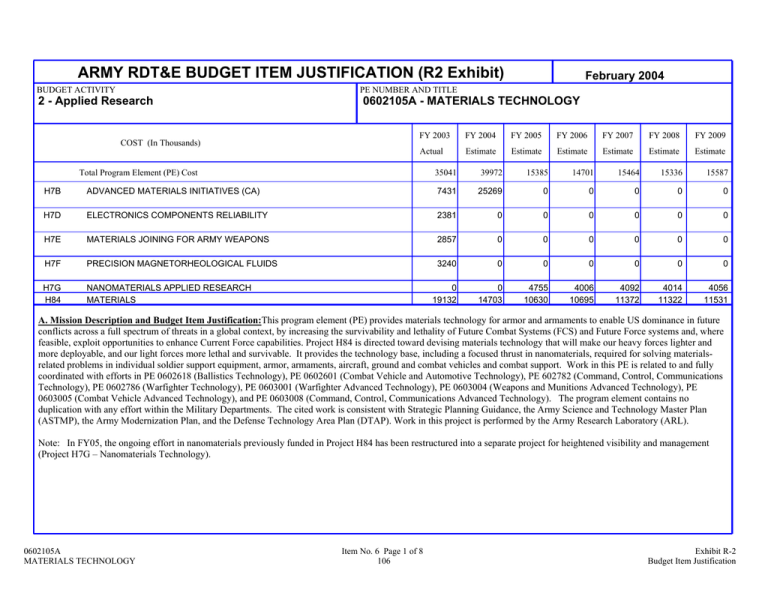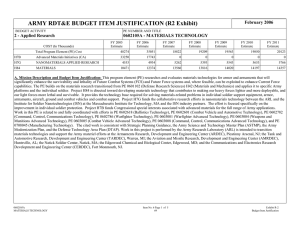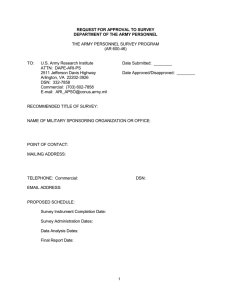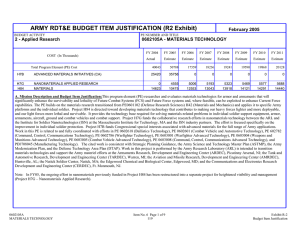ARMY RDT&E BUDGET ITEM JUSTIFICATION (R2 Exhibit) February 2004
advertisement

ARMY RDT&E BUDGET ITEM JUSTIFICATION (R2 Exhibit) BUDGET ACTIVITY 2 - Applied Research COST (In Thousands) February 2004 PE NUMBER AND TITLE 0602105A - MATERIALS TECHNOLOGY FY 2003 FY 2004 FY 2005 FY 2006 FY 2007 FY 2008 FY 2009 Actual Estimate Estimate Estimate Estimate Estimate Estimate Total Program Element (PE) Cost 35041 39972 15385 14701 15464 15336 15587 H7B ADVANCED MATERIALS INITIATIVES (CA) 7431 25269 0 0 0 0 0 H7D ELECTRONICS COMPONENTS RELIABILITY 2381 0 0 0 0 0 0 H7E MATERIALS JOINING FOR ARMY WEAPONS 2857 0 0 0 0 0 0 H7F PRECISION MAGNETORHEOLOGICAL FLUIDS 3240 0 0 0 0 0 0 H7G H84 NANOMATERIALS APPLIED RESEARCH MATERIALS 0 19132 0 14703 4755 10630 4006 10695 4092 11372 4014 11322 4056 11531 A. Mission Description and Budget Item Justification:This program element (PE) provides materials technology for armor and armaments to enable US dominance in future conflicts across a full spectrum of threats in a global context, by increasing the survivability and lethality of Future Combat Systems (FCS) and Future Force systems and, where feasible, exploit opportunities to enhance Current Force capabilities. Project H84 is directed toward devising materials technology that will make our heavy forces lighter and more deployable, and our light forces more lethal and survivable. It provides the technology base, including a focused thrust in nanomaterials, required for solving materialsrelated problems in individual soldier support equipment, armor, armaments, aircraft, ground and combat vehicles and combat support. Work in this PE is related to and fully coordinated with efforts in PE 0602618 (Ballistics Technology), PE 0602601 (Combat Vehicle and Automotive Technology), PE 602782 (Command, Control, Communications Technology), PE 0602786 (Warfighter Technology), PE 0603001 (Warfighter Advanced Technology), PE 0603004 (Weapons and Munitions Advanced Technology), PE 0603005 (Combat Vehicle Advanced Technology), and PE 0603008 (Command, Control, Communications Advanced Technology). The program element contains no duplication with any effort within the Military Departments. The cited work is consistent with Strategic Planning Guidance, the Army Science and Technology Master Plan (ASTMP), the Army Modernization Plan, and the Defense Technology Area Plan (DTAP). Work in this project is performed by the Army Research Laboratory (ARL). Note: In FY05, the ongoing effort in nanomaterials previously funded in Project H84 has been restructured into a separate project for heightened visibility and management (Project H7G – Nanomaterials Technology). 0602105A MATERIALS TECHNOLOGY Item No. 6 Page 1 of 8 106 Exhibit R-2 Budget Item Justification ARMY RDT&E BUDGET ITEM JUSTIFICATION (R2 Exhibit) BUDGET ACTIVITY PE NUMBER AND TITLE B. Program Change Summary 2 - Applied Research February 2004 0602105A - MATERIALS TECHNOLOGY FY 2003 FY 2004 FY 2005 Previous President's Budget (FY 2004) 33621 15186 14881 Current Budget (FY 2005 PB) 35041 39972 15385 1420 24786 504 Total Adjustments Congressional program reductions -351 Congressional rescissions Congressional increases 26100 Reprogrammings 1420 -963 SBIR/STTR Transfer Adjustments to Budget Years 504 Significant Change Explanation: FY04 - Eleven FY04 Congressional Adds totaling $26100 were added to this PE. FY04 Congressional Adds with no R-2As: ($2349) Advanced Material for Mine Detection and Blast Mitigation, Project H7B: The purpose of this one year Congressional add is to fund research in developing advanced materials for mine detection and blast mitigation. No additional funding is required to complete this project. ($5638) Advanced Material Processing, Project H7B: The purpose of this one year Congressional add is to fund applied research in advanced material characterization and processing technologies for composite and metallic materials. No additional funding is required to complete this project. ($939) Ballistic Shields, Project H7B: The purpose of this one year Congressional add is to fund research in ballistic shields. No additional funding is required to complete this project. ($939) Center for Innovative Material for Infrastructure Study, Project H7B: The purpose of this one year Congressional add is to fund research in innovative materials for infrastructure. No additional funding is required to complete this project. ($1879) Composite Multifunction Material Technology for Future Combat Systems, Project H7B: The purpose of this one year Congressional add is to 0602105A MATERIALS TECHNOLOGY Item No. 6 Page 2 of 8 107 Exhibit R-2 Budget Item Justification ARMY RDT&E BUDGET ITEM JUSTIFICATION (R2 Exhibit) BUDGET ACTIVITY 2 - Applied Research February 2004 PE NUMBER AND TITLE 0602105A - MATERIALS TECHNOLOGY fund research in advanced lightweight materials processing technologies. No additional funding is required to complete this project. ($4039) Future Affordable Multi-Utility (FAMU) Materials for the Army FCS, Project H7B: The purpose of this one year Congressional add is to fund research in advanced lightweight materials processing technologies. No additional funding is required to complete this project. ($1315) Low Cost Enabling Technologies, Project H7B: The purpose of this one year Congressional add is to fund research in affordable processing of advanced multifunctional materials for a wide range of Army applications. No additional funding is required to complete this project. ($1691) Materials Joining for Army Weapons Systems, Project H7B: The purpose of this one year Congressional add is to fund research in affordable joining technologies, including friction stir welding and laser hybrid welding, to provide capability to join complex shapes, dissimilar materials, and out of tolerance parts (wide gaps). No additional funding is required to complete this project. ($939) Molecular Design of Polymer Nanocomposites, Project H7B: The purpose of this one year Congressional add is to fund research in the molecular design of polymer nanocomposites. No additional funding is required to complete this project. ($3193) Precision Polishing of Large Optics, Project H7B: The purpose of this one year Congressional add is to fund research to develop new approaches to affordably polishing large-scale optics three meters or greater in diameter. No additional funding is required to complete this project. ($1597) Titanium Powder Alloy Production, Project H7B: The purpose of this one year Congressional add is to fund research in titanium powder alloy production. No additional funding is required to complete this project. 0602105A MATERIALS TECHNOLOGY Item No. 6 Page 3 of 8 108 Exhibit R-2 Budget Item Justification ARMY RDT&E BUDGET ITEM JUSTIFICATION (R-2A Exhibit) BUDGET ACTIVITY 2 - Applied Research COST (In Thousands) H7G February 2004 PE NUMBER AND TITLE PROJECT H7G 0602105A - MATERIALS TECHNOLOGY FY 2003 FY 2004 FY 2005 FY 2006 FY 2007 FY 2008 FY 2009 Actual Estimate Estimate Estimate Estimate Estimate Estimate NANOMATERIALS APPLIED RESEARCH 0 0 4755 4006 4092 4014 4056 A. Mission Description and Budget Item Justification:This project integrates government and industry scientific capabilities on research to advance innovative nanomaterials technologies and exploit breakthroughs in nanomaterials basic research toward improving Future Force survivability, lethality, and sustainability. This project funds a collaborative research effort in nanomaterials technology between the Army Research Laboratory (ARL) and the Institute for Soldier Nanotechnologies (ISN) at the Massachusetts Institute for Technology, MA. The ISN program and associated nanomaterials research transitioned from PE 0602105A H84 beginning in FY05. The program element contains no duplication with any effort within the Military Departments. The cited work is consistent with Strategic Planning Guidance, the Army Science and Technology Master Plan (ASTMP), the Army Modernization Plan, and the Defense Technology Area Plan (DTAP). Work in this project is performed by the Army Research Laboratory (ARL). The work in this project was previously funded in PE 0602105A project H84. It has been restructured into a separate project to heighten visibility and management. Accomplishments/Planned Program - Devise and validate improved physics-based materials property models and concepts for multifunctional lightweight and responsive hierarchical material technologies and exploit breakthroughs in nanomaterials and multifunctional fiber processing technologies (e.g., scale-up of processes and fabrication into woven materials) to enable revolutionary Future Force survivability, lethality, and sustainability. Research conducted by ARL in collaboration with ISN Industry Partners. In FY05, validate multiple protective materials designs that incorporate at least three functions (e.g., ballistic, blast and fire/flame protection) with reduced weight within single integrated system and exploit selected processing methodology to fabricate prototype nanomaterials-based, functionally integrated specimens for evaluation with improved survivability and lethality. Totals 0602105A (H7G) NANOMATERIALS APPLIED RESEARCH Item No. 6 Page 4 of 8 109 FY 2003 FY 2004 FY 2005 0 0 4755 0 0 4755 Exhibit R-2A Budget Item Justification ARMY RDT&E BUDGET ITEM JUSTIFICATION (R-2A Exhibit) BUDGET ACTIVITY 2 - Applied Research COST (In Thousands) H84 February 2004 PE NUMBER AND TITLE PROJECT H84 0602105A - MATERIALS TECHNOLOGY FY 2003 FY 2004 FY 2005 FY 2006 FY 2007 FY 2008 FY 2009 Actual Estimate Estimate Estimate Estimate Estimate Estimate MATERIALS 19132 14703 10630 10695 11372 11322 11531 A. Mission Description and Budget Item Justification:The goal of this project is to provide the technical foundation for materials technology in metals, ceramics, polymers, and composites that are essential for lethal and survivable Future Combat Systems (FCS), Objective Force Warrior (OFW) and other Future Force platforms. In order to meet the challenge of the Army Vision, new systems must be significantly lighter, more deployable, and more sustainable. A barrier to this challenge is the requirement for new materials and structures solutions that offer significant weight reduction with improved performance, durability and cost reduction for application to individual soldier support equipment, armor, armaments, aircraft, ground combat vehicles, and combat support equipment. This project will address these needs through: nanomaterials research, improved physics-based material, mechanics, and structural models; high strain rate material characterization techniques; non-destructive inspection/evaluation technologies; new high strength/temperature materials and coatings; and advanced fabrication/processing methodologies. Applied research efforts are focused in armor/armament materials, as well as lightweight structural materials and materials affording protection against chemical, biological, or directed energy threats. The work is conducted at the Army Research Laboratory (ARL), Aberdeen Proving Ground, MD and Hampton, VA and provides required technologies for advanced development programs at the Armaments Research, Development and Engineering Center (ARDEC), Picatinny Arsenal, NJ; the Tank and Automotive Research, Development and Engineering Center (TARDEC), Warren, MI; the Aviation and Missile Research, Development and Engineering Center (AMRDEC), Huntsville, AL; the Natick Soldier Center, Natick, MA; the Edgewood Chemical and Biological Center, Edgewood, MD; and the Communications and Electronics Research Development and Engineering Center (CERDEC), Ft. Monmouth, NJ. This project also funds a collaborative research effort in nanomaterials technology between the ARL and the Institute for Soldier Nanotechnologies (ISN) at the Massachusetts Institute for Technology, MA, which will transition to 0602105A H7G beginning in FY05. The program element contains no duplication with any effort within the Military Departments. The cited work is consistent with Strategic Planning Guidance, the Army Science and Technology Master Plan (ASTMP), the Army Modernization Plan, and the Defense Technology Area Plan (DTAP). Work in this project is performed by the Army Research Laboratory (ARL). 0602105A (H84) MATERIALS Item No. 6 Page 5 of 8 110 Exhibit R-2A Budget Item Justification ARMY RDT&E BUDGET ITEM JUSTIFICATION (R-2A Exhibit) BUDGET ACTIVITY 2 - Applied Research PE NUMBER AND TITLE PROJECT H84 0602105A - MATERIALS TECHNOLOGY Accomplishments/Planned Program - Optimize lightweight armor materials/structures, processing methodology, and modeling and simulation tools to enable formulation of lightweight frontal and structural armors that will revolutionize FCS and Future Force platform survivability. In FY03, optimized lightweight composite and ceramic armor materials/structures and transitioned technology to FCS vehicle designers for formulation of FCS Increment 1 armors. In FY04, provide and evaluate improved materials and processes to include multispectral and transparent ceramics that increase performance of FCS armor systems and create computational methodologies for design of blast and impact-resistant multifunctional (e.g., power, communications, propulsion, sensory) composite structures for FCS enhancement. In FY05, prove low cost processing of enhanced structural armor, metallics, and ceramics to enable advanced armor technology formulation and validate computational methodologies for design of blast and impact-resistant multifunctional (e.g., power, communications, propulsion, sensory) composite structures critical for fullspectrum survivability of FCS/Future Force platforms. - Optimize lightweight armor materials and defeat mechanisms against emerging threats and provide advanced processing techniques to enable affordable design of future multifunctional ballistic protective systems for the Future Warrior. In FY03, matured physics based design tools and provided novel lightweight materials solutions capable of defeating existing ballistic threats to Natick Soldier Center for use in Objective Force Warrior (OFW) protective systems; and employed advanced models and processing techniques to optimize performance of promising nano-structured materials and multi-functional coatings that will provide improved protection and sustainability for the Future Force. In FY04, optimize lightweight armor materials and defeat mechanisms against emerging threats and provide prototype armors that incorporate advanced processing techniques to enable affordable design of future multifunctional ballistic protective systems for the Future Warrior. In FY05, validate computational models and investigate armor materials and processing techniques that will enable the fabrication of an ensemble with integrated warrior electronic devices and multi-functional ballistic protection. 0602105A (H84) MATERIALS February 2004 Item No. 6 Page 6 of 8 111 FY 2003 FY 2004 FY 2005 4155 4005 4111 3128 1575 2292 Exhibit R-2A Budget Item Justification ARMY RDT&E BUDGET ITEM JUSTIFICATION (R-2A Exhibit) BUDGET ACTIVITY 2 - Applied Research PE NUMBER AND TITLE PROJECT H84 0602105A - MATERIALS TECHNOLOGY Accomplishments/Planned Program (continued) - Design, validate, and optimize advanced materials (ceramic, composite, polymers, lightweight metals) and processing techniques for smaller more lethal penetrators/warheads and affordable, lightweight high performance armaments for revolutionary Future Force lethality. In FY03, synthesized candidate penetrator/warhead alloys (Bulk Amorphous Materials, Nano-grain Tungsten, etc), evaluated their ballistic performance against threat armors, and established transition of promising medium caliber penetrator materials to ammunition designers; characterized and down-selected candidate ceramics and designed gun barrel sheathing technology required for improved armaments; and designed, fabricated, and experimentally validated prototype metal matrix composite projectile shell and transitioned design methodology to ammunition designers for application to lightweight, lethal FCS/Future Force munitions. In FY04, characterize failure mechanisms in emerging antiarmor materials and investigate effects of processing variables and constituents for improved design of penetrators/warheads; and prove thermally robust sheathing techniques capable of inducing a multi-axial compressive stress to insure structural integrity of sheathed ceramics subjected to internal pressure loading to enable improved armaments for the Future Force. In FY05, transition improved anti-armor materials and ceramic gun barrel technology to ARDEC/AMRDEC. - Design and optimize electro-ceramic materials and processing techniques for integration by CERDEC into advanced antennas that will enable affordable, reliable Command, Control, Communications (C3) Information for FCS and Future Force platforms. In FY03, designed and fabricated new electro-ceramic materials (thin film acceptor doped BST films) for discrete and integrated microwave applications including fire control radar, smart munitions, and point-to-point communications. In FY04, validate affordable processing methods to improve performance and integration into communication systems for FCS. In FY05, transition technology to CERDEC. 0602105A (H84) MATERIALS February 2004 Item No. 6 Page 7 of 8 112 FY 2003 FY 2004 FY 2005 5059 3790 3727 500 500 500 Exhibit R-2A Budget Item Justification ARMY RDT&E BUDGET ITEM JUSTIFICATION (R-2A Exhibit) BUDGET ACTIVITY 2 - Applied Research PE NUMBER AND TITLE PROJECT H84 0602105A - MATERIALS TECHNOLOGY Accomplishments/Planned Program (continued) - Devise and validate improved physics-based materials property models and concepts for multifunctional lightweight and responsive hierarchical material technologies and exploit breakthroughs in nanomaterials and multifunctional fiber processing technologies (e.g., scale-up of processes and fabrication into woven materials) to enable revolutionary Objective Force Warrior survivability and lethality. Research conducted by ARL in collaboration with ISN Industry Partners. In FY03, exploited material breakthroughs to design and fabricate flexible materials concepts for individual ballistic and stab protection based on shearthickening nanomaterial fluids and nanostructural fiber coatings; matured polymer nanocomposites for transparent armor and scratch resistant coatings; fabricated nanostructured polymer membranes which exhibit selective permeability for use in chem/bio protective garments; devised and implemented unique methods to characterize and model the ballistic response of nanomaterials and fibers; and proved novel lightweight energy absorbing nanomaterials for experimental evaluation and scaleup. In FY04, design and devise scalable processing/synthesis methods and show improved physics-based materials property models. In FY05, validate multiple protective materials designs that incorporate at least three functions (e.g., ballistic, blast and fire/flame protection) with reduced weight within single integrated system and exploit selected processing methodology to fabricate prototype nanomaterials-based, functionally integrated specimens for testing and evaluation with improved survivability and lethality. Advanced Coatings Research to Extend the Service Life of Vehicles and equipment: This one year congressional add focused on providing novel coatings to improve the reliability/durability, and significantly reduce life-cycle costs, of Army Materiel. No additional funding is required to complete this project. Small Business Innovative Research/Small Business Technology Transfer Programs Totals 0602105A (H84) MATERIALS February 2004 Item No. 6 Page 8 of 8 113 FY 2003 FY 2004 FY 2005 5321 4761 0 969 0 0 0 72 0 19132 14703 10630 Exhibit R-2A Budget Item Justification




